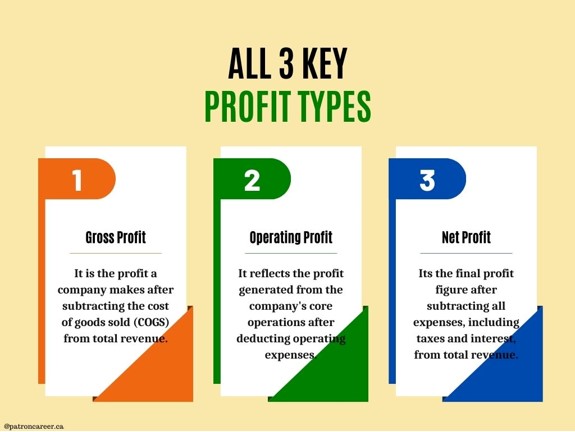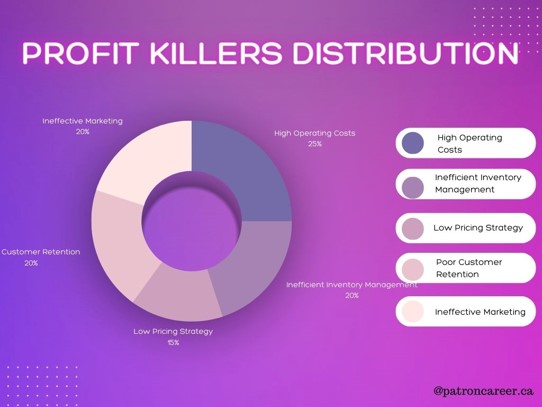
Business Planning
24 August, 2023
Patron Career Staffing firmly believes in adopting a tailored approach to meet temporary and permanent recruitment needs. We safeguard the interest of our clients by finding such workers who are knowledgeable and reliable.
About UsNeed help? Make a Call
32 Dundas Street East Unit A, L5A1W2

Abstract: Worried about profits draining from your company’s reserves? PCS got you covered! Learn how to safeguard your company’s profits with these practical strategies in our latest blog. Discover ways to manage costs, set competitive prices, optimize inventory, retain customers, enhance marketing, boost employee productivity, embrace technology, and diversify your offerings. Protect your bottom line with our actionable strategies for long-term sustainability and growth. Read the full article here:
Several Canadian companies over various industrial facets combat leaking profits despite efficacious operations. They get in the way of achieving maximized profits without having any idea of it and end up losing their elite position in the competitive marketplace. Profit margin and profit maximization are two key concepts that drive the success and sustainability of a business. Every entrepreneur's ultimate goal is to maximize their profit margins, as they are the élan vital of any organization. However, various factors can erode profits, making it essential to identify and address these profit killers.
In this blog, we'll list down a few causes that may be slowing down or even diminishing your business returns. We shall explore what profit margin and profit maximization mean, and their significance in business sustainability, delve into eight common profit killers and provide strategies to avoid them.
Defining: Profit Margin and Profit Maximization
Profit Margin: Profit margin is the percentage of revenue a company retains as profit after all expenses are deducted. Simply stated, it is the ratio of gross profits divided by the net sales of an organization. All company's ultimate goal is the maximization of profits. To reach there, profit margin is a crucial metric that indicates how efficiently a company operates and its ability to generate profit from its business endeavours.

Profit Maximization: Profit maximization is the process of increasing the net income of a business while simultaneously minimizing costs. It is the primary objective of most businesses, as it ensures financial stability and growth.
Now that we are abridged with what profit margin and profit maximization are, the next vital question that arises is, “How is profit margin relevant for my business?”. The line of businesses varies from one industry, business model, and business goals to another but the answer lies in the basic operational aims of every other business. Let’s understand a few of them.
The Crucial Role of Profit in Sustaining a Business
Profit is essential for several reasons:
a. Survival: Without profits, a business cannot cover its costs and is at risk of bankruptcy.
b. Growth: Profits provide the necessary capital for investment and expansion.
c. Innovation: Profitable businesses can invest in research and development, staying competitive.
d. Attracting Investors: Investors are more likely to invest in a profitable business.
Let's dive deeper into the eight common profit killers and explore comprehensive methods to avoid them:

1. High Operating Costs:
Profit Killer: Excessive operating expenses can significantly reduce profit margins. These costs include rent, utilities, employee salaries, and other overhead expenses.
Avoidance Strategies:
. Regular Expense Audits: Conduct frequent audits of your operating costs to identify areas where you can cut unnecessary expenses.
. Negotiate Contracts: Negotiate with suppliers and service providers for better terms and pricing.
. Energy Efficiency: Invest in energy-efficient appliances and practices to reduce utility bills.
. Remote Work: Consider remote work options to reduce office space requirements and related expenses.
2. Low Pricing Strategy:
Profit Killer: Under-pricing your products or services may lead to slim profit margins, making it challenging to cover costs and invest in growth.
Avoidance Strategies:
. Cost-Plus Pricing: Calculate the cost of producing or providing your product or service, then add a reasonable profit margin.
. Competitor Analysis: Study your competitors' pricing strategies and position your offerings competitively.
. Value-Based Pricing: Price your products or services based on the value they provide to customers, allowing for higher prices if the perceived value is high.
3. Inefficient Inventory Management:
Profit Killer: Poor inventory management can result in overstocking (tying up capital) or understocking (missing sales opportunities).
Avoidance Strategies:
. Inventory Tracking Systems: Implement inventory tracking software to monitor stock levels in real time.
. Just-in-Time (JIT) Inventory: Adopt JIT principles to reduce excess inventory and storage costs.
. Demand Forecasting: Use historical data and market trends to forecast demand accurately.
4. Poor Customer Retention:
Profit Killer: Losing existing customers is costly, as acquiring new ones often requires more resources and marketing expenses.
Avoidance Strategies:
. Customer Relationship Management (CRM) Systems: Utilize CRM software to track customer interactions and nurture relationships.
. Customer Feedback: Solicit feedback from customers and use it to improve products, services, and customer experiences.
. Loyalty Programs: Implement loyalty programs or incentives to reward and retain loyal customers.
5. Ineffective Marketing:
Profit Killer: Misguided marketing efforts can lead to wasted resources and reduced profits, especially if you are not reaching your target audience effectively.
Avoidance Strategies:
. Data-Driven Marketing: Use data analytics to understand your audience and tailor marketing campaigns accordingly.
. Marketing ROI Analysis: Continuously monitor and analyze the return on investment for marketing channels to allocate resources wisely.
. A/B Testing: Experiment with different marketing strategies and measure their effectiveness to refine your approach.
6. Neglecting Employee Productivity:
Profit Killer: Low morale and productivity among employees can lead to inefficiencies, errors, and decreased profitability.
Avoidance Strategies:
. Employee Training: Invest in training and development programs to enhance skills and motivation.
. Recognition and Rewards: As a business enthusiast, one needs to develop recognition habits and reward employees often for their bountiful achievements and milestones.
. Effective Leadership: Ensure effective leadership and communication within the organization to maintain a positive work environment.
8. Lack of Diversification:
Profit Killer: Relying on a single product, market, or customer segment can make your business vulnerable to economic fluctuations and market changes.
Avoidance Strategies:
. Market Research: Continuously research and identify new opportunities and markets for expansion.
. Product Development: Diversify your product or service offerings to cater to different customer needs.
. Risk Assessment: Regularly assess potential risks associated with overdependence on specific markets or products.
Also read: Mastering the Art of Business Planning
Conclusion
Quondam scrutinization, or sporadic analysis for above mentioned profit killers may leave you even more unrewarded in terms of generating profits. Canadian businesses- no matter small or big, should sensitize themselves to the importance of profit margin and profit maximization to be able to make a lot of money and generate sales. Similarly, to sustain profitability, it's crucial to identify and address common profit killers. By managing costs, pricing strategically, optimizing inventory, nurturing customer relationships, investing in marketing and technology, engaging employees, and diversifying, you can safeguard your profits and ensure the long-term success of your business.
We hope you found our blog helpful. Keep in touch with our blogs section, to gain insights about common business terms, useful tips and more.
